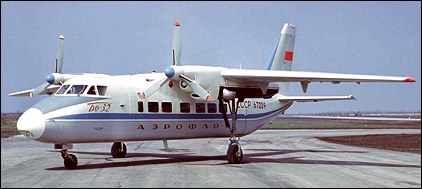|
| The most unusual factor about the Beriev Be-30 short-haul transport is the fact that it was the first landplane to be designed and developed by the Beriev design bureau. Seen publicly for the first time at the Soviet Aviation Day display at Domodedovo in 1967, it appeared subsequently at the 1969 Paris Air Show. Designated Be-30, and allocated the NATO codename 'Cuff, it was reported to have flown for the first time on 3 March 1967. Of high-wing monoplane configuration, the Be-30 was of all-metal structure and introduced such features as metal bonding, spot welding, and the use of stiffened skin panels of light alloy honeycomb. Because of the high-wing configuration, the retractable tricycle landing gear incorporated very stalky main units, these retracting into the rear of the engine nacelles. Power-plant of the prototype consisted of two 552kW Shvetsov ASh-21 radial piston engines, but two Glushenkov TVD-10 turboprops were used to power the very small number of production aircraft that followed. Accommodation was provided for a crew of two and 14 passengers, and advanced features included air-conditioning and blind-flying equipment that incorporated an autopilot and an automatic approach system.
It had been anticipated that the Be-30 would be built in large numbers for Aeroflot, but only a few were produced, presumably because of a decision to use the Czech Let L-410 Turbolet, of slightly larger capacity, as the standard short-haul type for service with Aeroflot.
| MODEL | Be-32 |
| ENGINE | 2 x Glushenkov TVD-10 turboprops, 708kW |
| WEIGHTS |
| Take-off weight | 5860 kg | 12919 lb |
| DIMENSIONS |
| Wingspan | 17.0 m | 56 ft 9 in |
| Length | 15.7 m | 52 ft 6 in |
| Height | 5.46 m | 18 ft 11 in |
| Wing area | 32.0 m2 | 344.44 sq ft |
| PERFORMANCE |
| Cruise speed | 480 km/h | 298 mph |
| Range | 1300 km | 808 miles |
| Andres Erdos, e-mail, 09.10.2012 22:27 The Beriev Be-30 (NATO reporting name "Cuff") is a Russian regional airliner and utility transport aircraft designed by the Beriev Design Bureau. It was developed specifically for Aeroflot local service routes using short, grass airstrips. It was also designed to be used in the light transport, aerial survey and air ambulance roles. It competed against the Antonov An-28 and the Czechoslovakian LET-410.
The original design featured interconnected engines, so that in case of one engine failing, the remaining engine could drive both propellers. This feature was not implemented in the production version.
The first prototype flew on 3 March 1967, fitted with Shvetsov ASh-21 piston engines, while the first production prototype flew on 18 July 1968, using more powerful Glushenkov TVD-10 turboprop engines. The first deliveries to Aeroflot were in mid-1969.
The Be-30 was designed for a flight crew of two with passenger arrangements for 14 (in the Be-30) to a maximum of 17 (in the Be-32) seated two abreast. Corporate shuttle configuration seated seven. The air ambulance configuration could accommodate nine stretcher patients, six seated patients and one medical attendant.
Three Be-30s and five Be-32s were built in the late 1960s before program terminated. In the early 1990's one of the original Be-32s was converted to Be-32K demonstrator and presented at the 1993 Paris and Dubai air shows. It was painted in the colors of the now defunct Moscow Airways which had ordered 50 aircraft but ceased operations before any could be built or delivered.
In September 1996 it was announced that the Be-32 would be produced by IAR in Romania, but these plans were later denied. In 1998 it was stated that the Be-32K would be built by Taganrog Aviation, but flight testing was reportedly still under way in 1999. Apparently there has not been much progress in recent years, and as far as is known, no new aircraft have been built since the mid seventies.
Variants:
Be-30 Prototype first flew on 3 March 1967, powered by two 550kW (740hp) ASh-21 piston radial engines, driving three blade constant speed propellers. Fuel capacity 1,000kg (2,204 lb).
Be-30: Production model
Be-30A: With 'high-density' seating for 21-23 passengers
Be-32: Upgraded model first displayed in 1993. Two 754kW (1011shp) Glushenkov (Omsk) TVD-10B turboprops driving three blade constant speed propellers.
Be-32K: 'Westernized' version with two 820kW (1100shp) Pratt & Whitney PT6A-65B turboprops driving three blade Hartzell reversible pitch propellers. Fuel capacity 2250ltr (594USg)
General characteristics-
Crew: 2
Capacity: 14-16 passengers
Length: 15.7 m (51 ft 6 in)
Wingspan: 17.0 m (55 ft 9 in)
Height: 5.52 m (18 ft 2 in)
Wing area: 32 m² (340 ft²)
Empty weight: 3,607 kg (7,937 lb[2])
Useful load: 1,500 kg (3,300 lb)
Max. takeoff weight: 5,860 kg (12,920 lb)
Powerplant: 2 × Glushenkov TVD-10 turboprop engines, 708 kW (950 shp) each
Performance-
Maximum speed: 480 km /h (260 kn, 300 mph) at 2,000 m (6,500 ft)
Cruise speed: 460 km /h (250 kn, 290 mph) at 2,000 m
Range: 1,300 km (700 nmi, 810 mi) reply | | andre verdon, e-mail, 21.09.2012 02:19 was the re engining wtht a PT6 was achived and produced. reply | | Davies, e-mail, 18.05.2007 14:55 We want to purchase your product.
Reply me reply |
|
Do you have any comments?
|
| 
COMPANY
PROFILE
All the World's Rotorcraft
|






